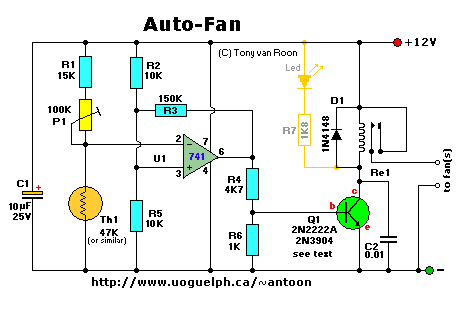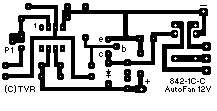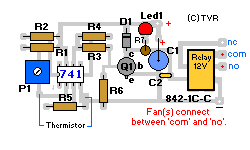
"This circuit was designed to automatically activate a set of three or four small DC fans to
cool a large cool-rib for a 10 Amp powersupply. Can be used in a variety of other applications as well."
Table 1
| Part |
Description |
Radio Shack |
Digi Key |
Newark |
Notes |
| IC1 |
LM741 Op-Amp |
276-007 |
LM741CN-ND |
LM741CN |
NE741,µA741, etc. |
| Q1 |
2N2222A transistor |
276-2009 |
2N2222A-ND |
2N3904 |
See text |
| D1 |
1N4148 Diode |
276-1122 |
1N4148GICT-ND |
1N4001 |
1N4001, or others |
| Th1 |
50K Thermistor |
|
KC005T-ND |
96F3309 |
KC005T in prototype |
| Re1 |
12V Relay |
275-249 |
Z753-ND |
83F8057 |
RS is 1A |
| R1 |
15K, 5% resistor |
|
|
84N2487 |
brown-green-orange |
| R2,R5 |
10K, 5% resistor |
|
|
84N2479 |
brown-black-orange |
| R3 |
150K, 5% resistor |
|
|
84N2485 |
brown-green-yellow |
| R4 |
4K7, 5% resistor |
271-1330 |
|
50N1628 |
yellow-purple-red |
| R6 |
1K, 5% resistor |
271-1321 |
|
50N6012 |
brown-black-red |
| R7 |
1K8, 5% resistor |
|
|
|
brown-gray-red |
| P1 |
100K Trimmer Pot |
|
|
|
Bourns |
| C1 |
10uF/25V Capacitor |
|
|
|
Electrolytic |
| C2 |
0.01uF, Capacitor |
|
|
|
Ceramic |
| Led |
Red, 3mm |
|
|
|
Light Emitting Diode |
Replacement Parts:
Q1 = 2N3053, 2N3904, NTE123A, ECG123A, NTE128, ECG128, etc.
D1 = 1N4001, NTE519, ECG519, NTE116 etc.
Th1 = Thermistor, 22K - 100K. Used 50K in prototype.
Re1 = Relay, type 842-1C-C from "Mode Electronics". Order # 50-333-0 ($1.55)
A reed relay will work fine also.
Couple Notes:
Th1, the 50K thermistor, is a standard type. Mine was a bar or rectangular looking thingy. Available from
Tandy/Radio-Shack. Almost any type will do. I experimented with different models from 22K to 100K and all worked fine
after replacing the trimmer pot and a little bit of tuning.
The one used in the above circuit diagram was a 50K model made by Fenwal (#197-503LAG-A01). This 50K was measured at
exactly 25 °C and with 10% tolerance. The resistance increases as the surrounding temperature decreases.
Tolerance for my application (cooling a large powersupply coolrib) is 10%. Another name for this thing is 'NTC'.
NTC stands for "Negative Temperature Coefficient" which means when the surrounding temperature decreases the
resistance of this thermistor will increase. You may have to shop around to get the cheapest price. Some thermistors
can be had for as little as $4.00 but as much as $55.00 Canadian currency for the glass encapsulated type (the best).
I replaced my thermistor for a 60K hermetically sealed glass type since the environment for my application may contain
corrosive particles which may affect performance on a future date.
P1 is a regular Bourns trimmer and adjusts a wide range of temperatures for this circuit. I used the
10-turn type for a bit finer adjustment but the regular type will work for your application.
R1 is a 'security' resistor just in case the trimmer pot P1 is adjusted all the way to '0' ohms. At which time the
thermistor would get the full 12 volt and it will get so hot that it puts blisters on your fingers... :-)
R3 feeds a bit of hysteresis back into the op-amp to eliminate relay 'chatter' when the temperature of the thermistor
reaches its threshold point. Depending on your application and the type you use for Q1 and Re1, start with 330K or so
and adjust its value downwards until your satisfied. The value of 150K shown in the diagram worked for me. Decreasing
the value of R2 means more hysteresis, just don't use more then necessary. Or temporarily use a trimmer pot and read
off the value. 120K worked for me.
Transistor Q1 can be a 2N2222(A), 2N3904, NTE123A, ECG123A, etc. Not critical at all. It acts only as a switch for
the relay so almost any type will work, as long as it can provide the current needed to activate the relay's coil.
D1, the 1N4148, acts as a spark arrestor when the contacts of the relay open and eliminates false triggering. For my
application the 1N4148 was good enough since the tiny relay I used was only 1 amp. However, you can use a large
variety of diodes here, my next choice would be a regular purpose 1N4001 or something and should be used if your relay
type can handle more then 1 amp.
Circuit digagram, PCB, and Layout are updated with C1, C2, R7, and Led. C1 and C2 are new to
eliminate switching noise from the relay in some applications. The optional Led and resistor have been added to the
circuit board and layot for your convenience. The relay used here and in the KIT is a small 12V/0.5A type. If the
relay rattles increase the feedback resistor R3 to 180K or a little higher, and small ceramic cap over the coil
connections in parallel with diode D1. A 1N4148 diode is specified for a small relay. If you use a larger relay used
a 1N4001 or 1N4004.
If you like to make your own pcb, try the one below. The pcb is fitted with holes for the relay but may not fit your
particular relay. It was designed for a Aromat HB1-DC12V type. The variety and model of relays is just to great.
How to mount it then? Well, I left ample space on the pcb to mount your relay. You can even mount it up-side-down and
connect the wires individually. Use Silicon glue, cyanoacrylate ester (crazy glue), or double-sided tape to hold the
relay in place. Works well. Note that the pcb and layout is not according to the circuit diagram in regards to the hookup
of the fans. The PCB measures approximately 1.5 x 3 inches (4.8 x 7.6mm)
If you print the pcb to an inkjet printer it is probably not to scale. Try to fit a 8-pin ic socket on a printed copy
to make sure it fits the scale before printing to a transparancy sheet and making the pcb...







